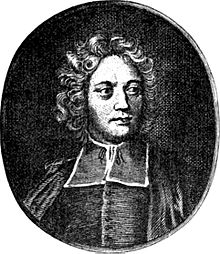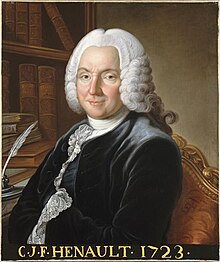Club de l'Entresol
Club de l'Entresol , (or mezzanine clubs) was a discussion group founded in Paris in 1724 that existed until 1731. Its aim was the free discussion of political and economic questions.
history
The Club de l'Entresol (literally translated club on the mezzanine or mezzanine floor ) was a meeting place or salon , which Pierre-Joseph Alary and Charles-Irénée Castel de Saint-Pierre (Abbé de Saint-Pierre) based on the English model for free discussion was founded by political and economic issues in 1724. The people met Saturday's seventeen to twenty clock in space Hôtel de Créqui (now Hôtel du Président Hénault de Cantorbe ), N ° 7 Place Vendome , one he arrondissement de Paris, in an apartment on the mezzanine floor of the French writer and historian Charles-Jean-François Hénault (1685–1770).
Charles-Irénée Castel de Saint-Pierre and probably also the other participants use the club to bring their own positions and ideas into a discursive public debate. Many of his memoranda and treatises on political, educational and moral-philosophical topics were presented to the Club de l'Entresol, such as Projet de Taille tarifée (1723), Mémoire pour diminuer le nombre des procès (1725) in which a uniform French law or Oeuvres diverses (1733-1? 41), Réflexions sur l'Anti machiavel (1740). From the perspective of Abbé de Saint-Pierre, this discussion group represented in his organization the implementation of an Académie politique that he called for, which should deal with general socio-political issues in a publicly effective manner.
The meetings followed a set schedule. The first hour was devoted to reading excerpts from newspapers and publications, then answers to questions that were still open from the previous week were sought, and later the political comments, for example from former ambassadors and the like, were devoted to. Each participant was responsible for a topic that he had previously selected and worked on this for the following presentation.
The up to twenty participants in the loose round of were ready to freely exchange views and, in some cases, contributed with their expert knowledge.
Initially, in the first years of the reign of Louis XV. , could be discussed relatively freely about political and social issues. With increasing attention that the debating club found in influential circles committed to the Ancien Régime , the sanction followed : When content that was supposedly dangerous to the state reached the public, Louis XV left the hoard around 1731 , also under pressure from Cardinal Fleury Close clearing up .
literature
- Nick Childs: A Political Academy in Paris 1724-1731: The Entresol and Its Members. Studies on Voltaire and the Eighteenth Century. Voltaire Foundation, Oxford 2000.
- Lucien Lanier: Le Club de l'entresol, 1723-1731, discours de réception. Académie des sciences, de M. Yvert 1879.
- Peter Hanns Reill, Ellen Judy Wilson: Encyclopedia of the Enlightenment. (PDF; 6.8 MB) Facts on File, 2004.
- François Cadilhon: La France d'Ancien Régime: Textes et documents, 1484-1789. PU Bordeaux 2002, ISBN 2-86781-303-4 , pp. 331-333.
- Uwe Backes: Political Extreme (writings of the Hannah Arendt Institute for Totalitarian Research). Vandenhoeck & Ruprecht, 2006, ISBN 3-525-36908-5 , p. 86 ff.
- Pierre-Yves Beaurepaire: La France des Lumières 1715–1789. Histoire de France. Belin 2011, ISBN 978-2-7011-3365-2 , pp. 112-115.
Web links
Individual evidence
- ↑ Harvey Chisick: Historical Dictionary of the Enlightenment ( Historical Dictionaries of Ancient Civilizations and Historical Eras ). Scarecrow Press, 2005, p. 114.
- ↑ Pierre-Yves Beaurepaire: La France des Lumières 1715–1789. Histoire de France. Belin, 2011, ISBN 978-2-7011-3365-2 , p. 112.
- ↑ Monuments historiques
- ↑ Harvey Chisick: Historical Dictionary of the Enlightenment . P. 114.
- ↑ Portrait of Abbe Pierre-Joseph Alary
- ↑ Anke Date Masch: life and work of Charles Irenee Castell de Saint-Pierre. Grin-Verlag, 2009.
- ↑ Anke Date Masch: life and work of Charles Irenee Castell de Saint-Pierre. Grin-Verlag, 2009, p. 9 ff.
- ↑ Anke Date Masch: life and work of Charles Irenee Castell de Saint-Pierre. Grin-Verlag, 2009, p. 9.
- ↑ Ulrich Hof: The Europe of the Enlightenment. CH Beck, 1993, p. 105 ff.
- ↑ Anke Date Masch: life and work of Charles Irenee Castell de Saint-Pierre. Grin-Verlag, 2009, p. 9 ff.



